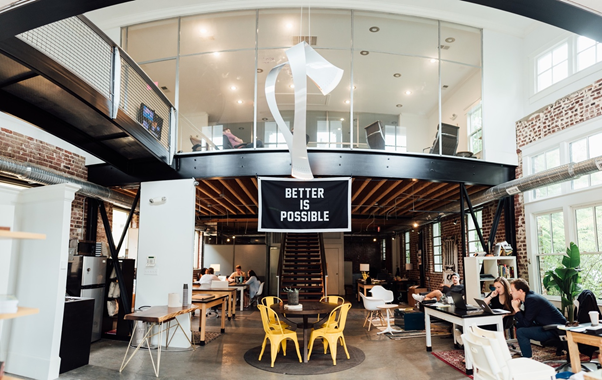
Find out why hot-desking often fails, and how you can make sure it doesn't.
When open-plan office designs came back in fashion in the '60s, personal space became sacred. Without walls, doors and name plaques to differentiate workspaces, invisible territories had to be staked out in other ways: personalised mugs, hand-written labels, novelty stress balls and carefully curated displays of family photographs. Then one day, out of the blue, hot-desking came along and everything was thrown into disarray.
As well as walls, office workers had to ditch their desks, take their personal items home and *gulp*... start to share spaces with their co-workers. The office turned into a free-for-all. That perfect spot you used to own (by the window, with the air conditioning and the nice pot plant), was suddenly the hottest turf in town. Everyone wanted a slice. Your co-workers were arriving earlier and earlier to claim it for the day and there was a constant uncertainty of whether you’d like where you’d be sitting next.
For some, hot-desking can mean discontent, anxiety and the daily annoyance of adjusting a new computer monitor, chair and desk set-up to suit their needs. However, when done right, hot-desking has a number of significant advantages – for employees and employers alike.
So, where are we going wrong?
Hot-desking: you're probably doing it wrong
One of the main disadvantages of hot-desking is that it can be tricky to put in place effectively in a way that benefits your business and your employees. You'll know you're doing hot-desking wrong if:
- Disgruntled employees feel turfed out and undervalued.
- Germs spread as people share dirty equipment.
- MSDs (Musculoskeletal disorders) result from poorly set up workstations.
- Business reports show lower productivity as people lose motivation.
- Morale drops because of the uncomfortable environment.
- People start to leave.
Hot-desking isn’t as simple as asking co-workers to share desks. It’s a delicate process that usually requires a solid strategy, expert guidance and specialist equipment.
Change Management Practitioner Holly Sorce presented a webinar for us about supporting staff through changes like the implementation of hot-desking and agile working. She said:
"We have to ask ourselves, what are the implications on staff when we're asking them to change their ways of thinking and transition to an agile or smart working environment? What is it that staff have to go through? We're asking them to break the comfort of the possession culture. That's moving from the sense that 'this is my desk, my pedestal, my cup in my part of the cupboard'. We're asking them to break that and move into a hot-desk scenario with shared locker space where nothing is theirs any more."
Change is often perceived as a threat. It can make people feel unsettled and out of control. To limit the negative impact of change, Holly suggests taking a change management approach. You can find out what this is and how to do it by watching her presentation here:
The benefits of hot desking
When done well, the benefits of hot-desking include:
- Frees up space for other perks, like comfortable break-out areas, fitness spaces and games rooms.
- Cuts the cost of running workstations.
- Encourages cross-departmental communication and collaboration.
- Encourages agile working - more movement between environments.
- Fosters more trust and loyalty.
- Stimulates health and productivity as staff are no longer rooted to the same spot every day.
How to make hot-desking work
To benefit from hot desking’s advantages, you’ll need to think carefully about implementing this new way of working. Here are some top tips.
Plan plan plan
As with any business decision, plan every move - the time it'll take, the resources needed and the budget you have. How will you communicate the change to staff? How will you support them and manage their needs? How will you redesign the space? What is your budget? Your time limit? What is your desired outcome and how will you measure its success?
Planning all of these factors will help make the transition a smooth one.
Be open about things
We're all human. We're all creatures of habit and change can be unsettling. Hot-desking takes away the comfort and familiarity of an 'owned' workstation. This is why it's important to be transparent with your staff. They need to be in the know or rumours and negativity will spread.
Hold a company-wide meeting, print posters, send emails with plans, ask for feedback and ideas. Getting staff involved creates a more inclusive, democratic culture.
Make hot-desking part of an agile working strategy
Think about the bigger picture. Hot-desking is just one element of agile working. Have you prepared a home-working policy? Are you going to consider sit-stand desks and other physical activity initiatives?
To get the maximum benefit of hot-desking you need to see it as a deeper, holistic change. It is about freeing your workforce, unshackling them from their desks and allowing them to use best judgement when it comes to the day's work environment. Find out more in our agile working section.
Get the right equipment
If you’re switching to a hot-desk environment, then it’s a good time to evaluate your office equipment. Is it up to the job? Does it comply with DSE regulations? Are chairs and computer monitors easily adjustable? Are they going to fit everybody in the office?
Our projects team specialises in tracking down and installing the perfect equipment for offices. They take into account all factors - budget, looks, ergonomic features and space. Popular hot-desking equipment recommended by our team includes:
- Opløft – A sit-stand platform specifically designed to be light and slim (when in flat position) enough to be easily picked up and stored away when not in use, ideal for sharing.
- Antimicrobial mice and keyboards – Made with plastic designed to kill germs.
- Laptop packs – These include a laptop stand, external mouse and keyboard to create a portable ergonomic workstation.
- Positiv range – Adjustable, affordable ergonomic chairs ideal for hot-desking.
- HÅG range – Stylish, highly adjustable ergonomic chairs.
Browse our collection of office chairs, sit-stand platforms, ergonomic mice, keyboards and laptop stands. Or why not opt for a sit-stand desk? For help choosing the right hot-desking chairs for your office, take a look at our Invest in Seating brochure.
Create a variety of spaces
If your teams aren't sitting together on a daily basis then it's important to provide plenty of places to hold meetings. Break-out areas with a more relaxed layout can be effective. Sofas, armchairs, and even swing chairs or hammocks can provide a change of environment that stimulates creativity and collaboration.
Make hot desking work for you
Planning well, communicating clearly and using space intelligently are the keys to effective hot-desking.
We would love to hear about your experience – is hot desking good? What are the benefits of hot-desking for an employee in your business? Or, if you haven’t tried it yet, are you now thinking about making the transition? Feel free to get in touch with our consultants for a chat.










